Metal detectorists dream of finding something of real historic value. One lucky detectorist in Scotland has made an astonishing find. He has found a very rare and beautifuly decorated early medieval knife in its original scabbard. This find is something of a first and is providing a window into medieval Scottish history.
The find was made by Christopher Johnstone in Deanburn Woods Penicuick, not far from the Scottish capital, of Edinburgh. According to the Edinburgh Evening News he ‘had worked out that woods near Penicuik were probably an escape route from a 1666 battle and he went to see what he could find’. This was the, which was part of the so-called Pentland Rising, a rebellion by Scottish Covenanters who were opposed to the religious policy of Charles II. As the Covenantors advanced upon Edinburgh ‘1,000 of them were intercepted and dispersed at Rullion Green, near Penicuik in the Pentland Hills’ according to Encylcopedia.com. Many of the rebels defeated at the Battle of Rullion Green were executed and others transported to the West Indies.

Site of the Battle of Rullion Green 1666. (Jim Barton / CC BY SA 2.0 )
Excalibur Moment
Mr Johnstone found some musket balls and this seemed to prove that he was right and he had indeed found the route taken by the defeated group after the battle in 1666. However, his detector also found something surprising. He found a small ornate knife in a scabbard that was caked in mud. Christopher told the Edinburgh Evening News that ‘The knife was stuck inside the scabbard and I thought it was the top of a railing someone had cut off’.
The knife was held firmly in the scabbard and could not be removed. Mr Johnstone took it to an archaeologist at Midlothian Council. She confirmed it was a knife and gave him advice on how to safely remove the weapon from the scabbard. The archaeologist told him to place the object into the oven with a low temperature with the door open. This allowed the detectorist to safely pull the knife from its sheath, without damaging it.
“The knife was stuck inside the scabbard and I thought it was the top of a railing someone had cut off.” https://t.co/wxwFW9YClh
— Edinburgh Evening News (@edinburghpaper) November 30, 2020
The Edinburgh Evening News quotes Christopher as saying that:
‘It was a pure Excalibur moment for me when I pulled out the handle and there was a blade.’
When he examined the scabbard he found two leather pieces that were used to protect the knife.
Mr Johnstone lives near the location of his discovery and has previously found a Bronze Age arrowhead, despite only taking up the hobby of metal detecting 6 months ago. He concluded that the knife was probably medieval and possibly dated to the 16th century.
Medieval Scottish knife
Under Scottish law, a metal detectorist needs to alert the authorities to any find that may be of historical significance. Mr Johnstone took it to the Treasure Trove which is responsible for recording and protecting historic objects unearthed in Scotland. However, according to Mr Johnstone they ‘dismissed it as a relatively modern item’ reports the Edinburgh Evening News . The metal detectorist did not agree with their conclusions and had the knife privately carbon dated .
Based on the tests he was told that it was up to 800 years old and that it was probably made sometime between 1191 and 1273. This was a dramatic period of Scottish history, which included the two Scottish Wars of Independence and the careers of heroes such as William Wallace and Robert the Bruce . Mr Johnstone told The Edinburg Evening News that ‘I wasn’t expecting it to come back with such an early date.’

The knife was removed from the scabbard without damage. (Craig Johnstone / Edinburgh Evening News )
Nobleman’s Knife
The metal detectorist believes that the knife, which is only three inches long and has a hollow-ground blade, is a skean dhu . They are also sometimes known as a ‘ Sgian Dubh’ or black knife in Gaelic according to Scottish Antiques . These small knives were often concealed in a waistband or under an armpit. This knife is highly decorated, and the blade may have been covered, possibly with silver. The bronze handle may also have once been coated in gold leaf.
Mr Johnstone told the Edinburg Evening News that “It would have belonged to a nobleman or someone of some substance. It was almost certainly owned by a member of the elite. He says he is not really interested in the monetary value of the object he just wants its historic importance to be recognized.
Mr Johnstone has passed on details of the findings of the carbon dating to Treasure Trove and they have passed it on to be examined by the Scottish Archaeological Finds Allocation Panel. They are investigating the artifact and will subject it to more tests to categorically date the knife and scabbard.
 Explore the clever ancient technologies, cunning weapons, and curious gadgets which shaped our modern world and still reflect the brilliance of ancient minds. Incredible ancient technologies leave us awe-struck at the knowledge and wisdom held by people of our past. They were the result of incredible advances in engineering and innovation as new, powerful civilizations emerged and came to dominate the ancient world. Many ancient inventions were forgotten, lost to the pages of history… Travel with Ancient Origins now to experience the surprising and clever “ Amazing Technologies of the Ancient World ”, here.
Explore the clever ancient technologies, cunning weapons, and curious gadgets which shaped our modern world and still reflect the brilliance of ancient minds. Incredible ancient technologies leave us awe-struck at the knowledge and wisdom held by people of our past. They were the result of incredible advances in engineering and innovation as new, powerful civilizations emerged and came to dominate the ancient world. Many ancient inventions were forgotten, lost to the pages of history… Travel with Ancient Origins now to experience the surprising and clever “ Amazing Technologies of the Ancient World ”, here.
Top image: Representational image of medieval knife Source: George / Adobe Stock
By Ed Whelan
Related posts:
Views: 0
 RSS Feed
RSS Feed

















 December 1st, 2020
December 1st, 2020  Awake Goy
Awake Goy  Posted in
Posted in  Tags:
Tags: 
















